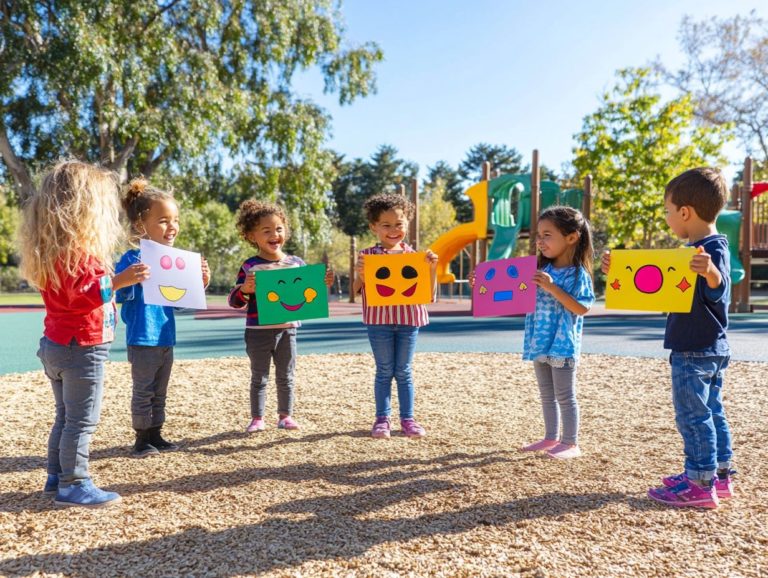Understanding Emotional Awareness in Different Cultures
Unlocking the power of emotional awareness can transform how you connect with yourself and others. This essential skill significantly shapes how you perceive yourself and engage with others. It can vary greatly across cultures, influencing your communication styles, relationships, and overall emotional intelligence. Understanding these cultural differences can help you understand different emotional situations more effectively.
In this article, you will delve into the essence of emotional awareness and its critical importance. You will explore how it manifests differently in individualistic versus collectivist societies and in high-context versus low-context cultures. You will also discover the impact of cultural norms and the role of emotional intelligence assessments in understanding these differences.
You will uncover the myriad benefits of grasping these cultural variations, address prevalent misconceptions, and discover practical tips for cultivating emotional awareness within a global context. You will learn about the MEIA-R assessment and the MEIA-W-R assessment, which are tools used to measure emotional intelligence across different cultures.
Join us on this enlightening journey to enhance your emotional intelligence as you navigate the rich tapestry of diverse cultural landscapes. By recognizing emotional patterns and employing emotional management strategies, you can improve your cross-cultural interactions.
Contents
- Key Takeaways:
- What is Emotional Awareness?
- Why is Emotional Awareness Important?
- How Does Emotional Awareness Differ Across Cultures?
- Understanding Cultural Contexts
- 3. Expressive vs Restrained Cultures
- What are the Benefits of Understanding Emotional Awareness in Different Cultures?
- How Can One Develop Emotional Awareness in Different Cultures?
- What Are Some Common Misconceptions About Emotional Awareness in Different Cultures?
- 1. Emotions are Universal
- 2. Emotional Expression is the Same Across Cultures
- 3. Cultural Stereotypes About Emotional Expression
- Frequently Asked Questions
- What is emotional awareness and emotional intelligence?
- Why is understanding emotional awareness in different cultures important?
- How does emotional awareness differ across cultures?
- Can emotional awareness be learned?
- What are the benefits of understanding emotional awareness in different cultures?
- Is emotional awareness culturally relative?
Key Takeaways:

- Understanding emotional awareness in different cultures leads to improved communication and better cross-cultural relationships.
- Developing emotional awareness in different cultures can be achieved through seeking cultural education, practicing active listening and empathy, and being open-minded and respectful.
- Common misconceptions about emotional awareness in different cultures include assuming emotions are universal and believing emotional expression is the same across cultures.
What is Emotional Awareness?
Emotional awareness is your ability to recognize, understand, and manage not only your own emotions but also the emotions of those around you. This skill is a vital part of emotional intelligence.
It involves self-awareness, emotional expression, and the capacity to reflect on your emotional experiences. By honing this awareness, you can navigate social interactions with greater ease and effectiveness.
As you deepen your emotional understanding, you also enhance your emotional competencies, which significantly improves your relationship management skills in various contexts, whether in the workplace or in personal relationships. Utilizing the self-report method can further help in assessing your emotional skills and identifying areas for emotional competencies development.
Why is Emotional Awareness Important?
Emotional awareness is essential, as it profoundly influences the dynamics of the workplace and overall job satisfaction. By cultivating emotional health through enhanced emotional regulation and understanding, you can elevate your leadership potential and make a meaningful impact on both individual and team performance. Tools like the MEIA-W-R assessment can provide insights into workplace emotional intelligence and aid in personal development.
When you develop emotional awareness, you are better equipped to manage your emotional responses, fostering healthier work environments and nurturing constructive relationships with your colleagues. This improved emotional capacity can lead to greater emotional intelligence and better performance at work.
How Does Emotional Awareness Differ Across Cultures?
Emotional awareness can differ greatly across cultures, shaped by the unique norms and contexts that govern emotional responses and expressions. As you navigate the diverse cultural landscapes, you might find yourself in situations where expatriate employees face distinct emotional dynamics, such as the contrast between individualism in the United States and collectivism in Japan. Understanding these differences is crucial for developing cultural intelligence, which is the ability to understand and adapt to different cultures, and adapting your emotional responses accordingly.
These cultural nuances significantly affect how you perceive and manage emotions, ultimately influencing your interpersonal relationships and interactions in the workplace. Understanding this cultural context is essential for fostering effective communication and collaboration in a global environment.
Understanding Cultural Contexts
1. Individualistic vs Collectivist Cultures
Understanding the cultural context of emotional awareness in individualistic and collectivist societies is essential for improving cross-cultural interactions.
The distinction between individualistic and collectivist cultures profoundly shapes emotional awareness. In individualistic cultures, such as those in North America, personal achievement and emotional expression reign supreme.
In contrast, collectivist cultures, like Japan and China, prioritize group harmony and emotional restraint. This fundamental difference influences how you recognize, communicate, and manage emotions in various societies.
For example, in individualistic settings, expressing emotions openly can enable you to foster authentic relationships, as seen in the way Americans celebrate joy or personal milestones.
In collectivist cultures, individuals often suppress their feelings to maintain social cohesion, leading to a more nuanced approach to emotional expression. This highlights the importance of the collective good versus individual success in shaping emotional norms.
In countries like India, emotional intelligence involves a deep understanding of others’ feelings while prioritizing the group’s well-being. However, this focus can result in misinterpretations of intent when viewed through a different cultural lens.
Exposure to such cultural background differences is essential for enhancing one’s understanding across cultures in emotional assessments.
The interplay between individualism and collectivism creates a rich tapestry of emotional competencies and intercultural relationships, underscoring the significance of context in understanding emotional health.
2. High Context vs Low Context Cultures
In high-context cultures, such as Japan and China, you’ll find that communication relies heavily on implicit emotional cues and non-verbal signals. This creates a nuanced landscape for emotional understanding.
On the other hand, low-context cultures like the United States and Canada prioritize direct emotional communication and explicit expression. Mastering these emotional dynamics can make a world of difference in your interactions across diverse cultural settings.
This distinction leads to significant variations in how individuals convey and interpret feelings. In high-context cultures, emotional awareness is deeply intertwined with social context, where subtle gestures, facial expressions, and situational nuances carry substantial significance.
As a result, relationships in these cultures often flourish on a foundation of shared experiences and unspoken understanding, allowing for rich emotional connections. However, this can present challenges for those who are not native to the culture.
Recognizing and adapting to these emotional challenges can significantly improve your ability to build meaningful relationships across different cultural settings.
Conversely, in low-context cultures, the focus shifts toward clear verbal communication and straightforwardness, often encouraging a more transparent dialogue about emotions.
While this approach can facilitate quick resolutions to misunderstandings, it may sometimes be perceived as brusque or lacking in emotional depth.
Recognizing these differences is essential for fostering effective interpersonal relationships and crafting emotional communication strategies that transcend cultural boundaries. Engaging in emotional training and learning about different emotional dynamics can further enhance your capability to navigate cross-cultural interactions.
3. Expressive vs Restrained Cultures

Expressive cultures, like those in Latin America and parts of Africa, warmly embrace emotional display and communication. In contrast, those from restrained cultures tend to emphasize stoicism, a philosophy that values emotional control and inner strength, viewing emotional restraint as a hallmark of strength and maturity.
These differing approaches to emotional awareness and expression illuminate intriguing dynamics in how individuals perceive and showcase their feelings. In expressive cultures, vivid displays of joy, sadness, or anger are not just acceptable; they re often celebrated, creating a supportive space where emotional connections can flourish. Such cultural exposure can greatly enhance one s ability to adapt to different emotional contexts.
In restrained cultures, emotional control plays a significant role in shaping people’s emotional feedback mechanisms; exposure to diverse cultural norms can enable individuals to adapt their emotional responses. By understanding these emotional norms, individuals can better navigate the complexities of cross-cultural emotional interactions.
As a result, someone immersed in an expressive environment may find it liberating to share their emotions more freely. In contrast, an individual from a more restrained background might initially struggle with this openness, highlighting the profound influence of cultural conditioning on emotional behavior.
What are the Benefits of Understanding Emotional Awareness in Different Cultures?
Understanding emotional awareness across various cultures brings valuable benefits that you can leverage immediately, including enhanced communication, stronger cross-cultural relationships, and a notable boost in emotional intelligence for both individuals and teams.
By recognizing and respecting the diverse ways in which emotions are expressed and understood, you can help cultivate an inclusive environment that promotes collaboration and drives productivity to new heights.
1. Improved Communication
Improved communication stands as one of the foremost advantages of cultivating emotional awareness, enabling you to navigate the intricate dynamics of emotions with finesse. This is supported by research published in Frontiers in Psychology and other academic journals.
When you become attuned to your own feelings and those of others, your responses to various situations become more deliberate and thoughtful. This invaluable skill can transform your interactions in a wide range of environments, whether you find yourself in the hustle and bustle of a workplace, among family members at a gathering, or engaged in a community meeting.
Consider the open-minded manager who recognizes the emotional cues of their team members. This awareness fosters an inclusive atmosphere, encouraging both creativity and collaboration. By employing active listening techniques alongside emotional feedback, you facilitate dialogues that enhance clarity and minimize misunderstandings. Such practices are advocated by resources like Greater Good Magazine, which emphasizes the importance of emotional intelligence in leadership.
Ultimately, these strategies not only fortify relationships but also nurture a culture where empathy and respect thrive, solidifying emotional intelligence as an essential element of effective communication.
2. Better Cross-Cultural Relationships
Having a deep understanding of emotional patterns and engaging in emotional learning can significantly improve your cross-cultural relationships, making these interactions more meaningful and effective.
You can cultivate better cross-cultural relationships by embracing emotional understanding, allowing you to navigate cultural differences with a sense of sensitivity and empathy.
This emotional awareness enhances your communication skills. It helps you recognize and appreciate the diverse emotional expressions and social cues that can vary significantly across cultures.
For example, you might observe that a smile in one culture signifies friendliness, while in another, it might indicate discomfort. By tuning in to these nuances, you can engage more thoughtfully, minimizing the risk of misunderstandings.
Demonstrating empathy in the face of cultural challenges can lead to deeper connections. When you actively listen and validate experiences that differ from your own, you create an inclusive atmosphere that fosters collaboration and mutual respect.
3. Developing Emotional Intelligence and Competencies
Increased emotional intelligence is a substantial advantage that comes from understanding emotional awareness across cultures. It enhances your ability to manage emotions and develop essential skills to understand and manage feelings for better relationship management and job satisfaction.
By recognizing the diverse emotional expressions, emotional patterns, and norms that exist within various cultural contexts, you can cultivate a deeper sense of empathy and adaptability. These traits are crucial in our interconnected world.
This understanding paves the way for improved communication and collaboration, enabling you to navigate and honor the unique emotional landscapes of those around you.
Participating in emotional training programs can greatly enhance your skills. These programs typically emphasize practicing mindfulness, active listening, empathy-building exercises, and emotional feedback.
All of these foster better emotional regulation and expressive control. By honing these emotional management techniques, you can significantly enhance your emotional intelligence and emotional capacities.
This leads to more effective interactions within multicultural environments and improves your leadership potential.
How Can One Develop Emotional Awareness in Different Cultures?
Cultivating emotional awareness across various cultures necessitates a nuanced approach. This involves engaging in cultural education, practicing active listening, fostering empathy, and embracing an open-minded attitude toward the diverse emotional expressions and norms that exist.
By doing so, you can navigate the complexities of emotional landscapes with greater sensitivity and understanding.
1. Seek Out Cultural Education and Training

Seeking out cultural education and training programs is essential for developing emotional awareness and enhancing your emotional intelligence, especially within diverse cultural contexts.
Engaging in these educational experiences allows you to grasp the nuances of emotional norms and expressions across different cultures. This fosters a deeper understanding of human behavior.
By participating in workshops that focus on intercultural communication, empathy training, or emotional skills development, you can learn how various societies interpret and express emotions.
Programs such as Emotional Intelligence Training offered by various institutes or Cultural Competency training are designed to equip you with skills that transcend cultural boundaries.
These initiatives not only enhance your personal emotional skills but also promote more harmonious interactions among diverse groups. Ultimately, this leads to a more emotionally intelligent society and improves cross-cultural validity in emotional assessments.
Start your journey toward greater emotional intelligence today!
2. Practice Active Listening and Empathy
Practicing active listening and empathy is essential for enhancing your understanding of feelings and fostering a deeper emotional connection in your personal relationships.
By committing to these techniques, you can create a safe space for open communication, ultimately breaking down the barriers that often hinder genuine connection.
Active listening goes beyond merely hearing the words spoken; it involves grasping the underlying emotions and intentions behind them. For example, when someone shares their struggles with you, reflecting back their feelings demonstrates that you truly value their experiences.
Empathy enables you to place yourself in another’s position, allowing you to recognize the cultural nuances that shape emotional responses. In multicultural contexts, this awareness can lead to more harmonious interactions, where diverse perspectives are both appreciated and acknowledged.
Such practices strengthen your personal bonds and enrich social dynamics, paving the way for mutual respect and compassion.
3. Be Open-Minded and Respectful
Being open-minded and respectful toward different cultural expressions of emotions is essential for cultivating your understanding of feelings and cultural intelligence.
This mindset enables you to navigate the intricate landscape of human emotions, recognizing that expressions of sorrow, joy, and even anger can differ significantly from one culture to another.
For example, a person from a collectivist society may exhibit emotional restraint, prioritizing group harmony over individual expression. In contrast, someone from an individualistic background might be more candid about their feelings.
By engaging in active listening and striving to understand these differences in emotional display, you can foster deeper connections.
This approach enhances personal relationships and broadens your cultural exposure, creating a more inclusive environment where emotional diversity is acknowledged, celebrated, and respected, contributing to the collective good.
What Are Some Common Misconceptions About Emotional Awareness in Different Cultures?
You might be surprised by the misconceptions surrounding emotional awareness across different cultures. One prevalent belief is that emotions are universal, along with the assumption that emotional expression and emotional responses remain consistent across all cultural contexts.
1. Emotions are Universal
The idea that emotions are universal is a misconception; your emotional responses and experiences can vary significantly across cultures, shaped by different backgrounds and norms.
Take a smile, for example. In many Western cultures, it’s typically a sign of happiness, but in certain parts of Asia, it might be a polite mask to hide embarrassment or discomfort.
Grief also showcases this divergence beautifully. In Mediterranean societies, mourners often express their sorrow loudly through communal rituals. In contrast, some East Asian cultures favor a more subdued approach, reflecting a deep respect for harmony and emotional health.
These variations challenge the belief in universal emotions, illustrating how profoundly culture impacts emotional expression and perception. They encourage you to reevaluate what it truly means to feel and express emotions within such diverse contexts and environments.
2. Emotional Expression is the Same Across Cultures
Believing that emotional expression is uniform across cultures overlooks the intricate cultural norms that dictate how emotions are exhibited and interpreted. As you explore various societies, you’ll likely notice significant differences in how individuals convey their feelings and communicate emotionally.
In many Western cultures, there s a strong encouragement to express emotions openly and directly, valuing assertive communication. In stark contrast, Asian cultures often celebrate emotional restraint, leading to a more nuanced display of feelings.
This dynamic can create misunderstandings; for example, your enthusiastic display of excitement as an American might come off as overwhelming or inappropriate in a more reserved cultural setting, such as in Japan or China.
Thus, it’s clear that cultural backgrounds not only shape emotional expression but also play a crucial role in influencing personal relationships, social interactions, and overall emotional capacities.
3. Cultural Stereotypes About Emotional Expression

Cultural stereotypes often perpetuate misconceptions about emotional expression. These misconceptions can lead to misunderstandings in emotional awareness between different cultural groups. Such stereotypes create significant barriers, especially when emotional cues are interpreted through the lens of your own cultural experiences and emotional context.
For instance, in certain cultures, displaying strong emotions might be perceived as a sign of weakness. This perception can make individuals hesitant to communicate their feelings openly. Conversely, some cultures view the expression of emotions as vital to personal authenticity. This difference can set the stage for potential clashes during interactions and emotional challenges.
Misunderstandings often lead to frustration and alienation. This weakens relationships and obstructs effective communication. Recognizing these nuanced differences is crucial for cultivating empathy and enhancing emotional intelligence across cultures.
Frequently Asked Questions
What is emotional awareness and emotional intelligence?
Emotional awareness is the ability to recognize and understand one’s own emotions as well as the emotions of others.
Why is understanding emotional awareness in different cultures important?
Cultures express and perceive emotions in unique ways. Understanding these differences helps bridge cultural gaps and promotes empathy and connection.
How does emotional awareness differ across cultures?
Some cultures may encourage open and expressive displays of emotions, while others value emotional restraint and control. The specific emotions considered appropriate to express can vary across cultures due to differing emotional norms and cultural context. Understanding these emotional patterns can enhance emotional intelligence and communication.
Can emotional awareness be learned?
Yes, emotional awareness can be developed through self-reflection, empathy, cultural exposure, and understanding of cultural differences. Emotional training and practice of emotional skills can contribute to better emotional self-awareness and relationship management.
What are the benefits of understanding emotional awareness in different cultures?
Understanding emotional awareness in different cultures can lead to improved communication and relationships. It reduces conflicts and misunderstandings while increasing cultural competence and sensitivity. This is particularly important for expatriate employees who navigate emotional responses in diverse backgrounds.
Is emotional awareness culturally relative?
Yes, emotional awareness is influenced by cultural norms and values. What is considered emotionally aware may vary across cultures. Understanding and respecting these differences is essential for enhancing emotional regulation and understanding. Emotional intelligence assessments, such as the MEIA-R and MEIA-W-R, can evaluate emotional competencies across different cultural contexts, ensuring cross-cultural validity. Recognizing emotional capacities and experiences within cultural settings can inform the development of emotional competencies.
Understanding emotional awareness significantly enhances your relationships and improves communication skills. Explore and learn more about emotional awareness across cultures to foster deeper connections.






